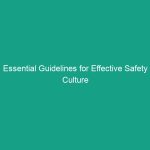Good Morning Team!
Today, we’re going to dive into a crucial topic that affects each and every one of us in our daily work: Essential Vibrations and Ergonomics Guidelines to Boost Workplace Safety. Understanding these guidelines is not just about compliance with Regulations; it’s about creating a safer, healthier workplace for all. So, let’s get started!
Understanding Essential Vibrations and Ergonomics
First things first, what do we mean by vibrations and ergonomics? Vibrations refer to oscillations or movements that can occur in machinery or tools we operate. Ergonomics, on the other hand, is the science of designing the workplace, keeping in mind the capabilities and limitations of the worker.
These two elements are critical in Workplace Safety. Poor ergonomics can lead to repetitive strain injuries, while excessive vibration exposure can cause long-term health issues such as hand-arm vibration syndrome. Therefore, recognizing the importance of these factors is key to ensuring our well-being at work.
Many people think that if they don’t feel immediate discomfort, they are safe. However, that’s a misconception. The Effects of poor ergonomics and vibrations can be cumulative, leading to serious health issues over time.
Key Hazards, Risks, and Safety Considerations
So, what are the specific Hazards and risks associated with vibrations and ergonomics? Let’s break it down:
- Vibrations: Prolonged exposure can lead to conditions such as Raynaud’s disease, nerve damage, and reduced grip strength.
- Poor Ergonomics: Improper workstation setup can result in back pain, carpal tunnel syndrome, and eye strain.
- Equipment Use: Using tools without proper ergonomics can increase the risk of accidents and injuries.
Ignoring these risks can lead to serious consequences, including decreased productivity, higher absenteeism, and increased medical costs. It’s vital that we take these guidelines seriously.
Best Practices, Procedures, & Actionable Advice
Now let’s talk about some Best Practices that we can incorporate into our daily routines:
1. Ergonomic Workstation Setup
Ensure your workstation is set up to minimize strain. Here are a few tips:
- Adjust your chair so your feet rest flat on the ground.
- Your monitor should be at eye level, about an arm’s length away.
- Use tools that are designed to reduce strain, such as ergonomic keyboards and mice.
2. Take Regular Breaks
It’s essential to take breaks to reduce muscle fatigue and prevent repetitive strain injuries:
- Follow the 20-20-20 rule: Every 20 minutes, look at something 20 feet away for 20 seconds.
- Stand up and stretch every hour.
3. Proper Tool Use
When using tools or machinery, follow these guidelines:
- Always use tools that fit your hand comfortably.
- Limit your exposure to vibrating tools; take breaks when using them.
- Use anti-vibration gloves when necessary.
4. Engage in Training
Participate in any training sessions offered on ergonomics and vibration Safety. Knowledge is power, and understanding how to protect yourself is key to maintaining your health.
Regulations, Standards, and Compliance
We must also be aware of the regulations that govern Workplace Safety:
- OSHA has established guidelines regarding permissible exposure limits for vibration.
- ISO Standards provide guidelines for ergonomic practices in various work environments.
Compliance with these regulations is not just a legal obligation; it’s a commitment to our safety and health. Following these standards helps protect you and your coworkers from potential hazards.
Employee Engagement & Discussion
Now, let’s open the floor for discussion. Here are a few questions to think about:
- What safety challenges have you encountered related to vibrations or ergonomics?
- Can you share any personal experiences where ergonomic practices have helped you work more comfortably?
- What other tools or strategies do you think could help improve our workspace ergonomically?
Your insights are invaluable, and together we can build a safer workplace.
Conclusion & Key Takeaways
To wrap things up, remember that understanding essential vibrations and ergonomics guidelines is vital for your safety and well-being. By implementing these practices, not only do we protect ourselves, but we also contribute to a culture of safety within our organization.
Thank you for your attention today. I encourage you all to prioritize safety and continuously look for ways to improve our work Environment. Let’s work together to create a safer and healthier workplace!


